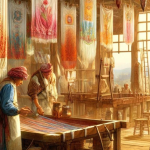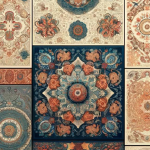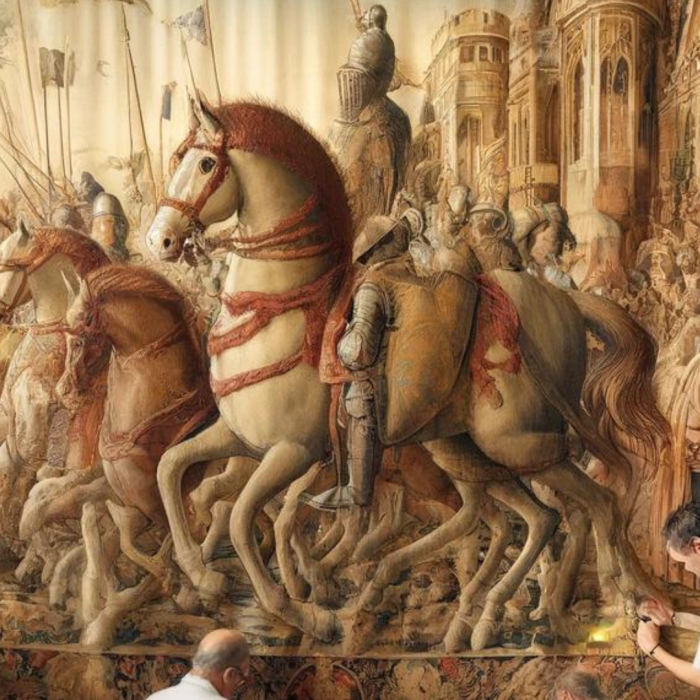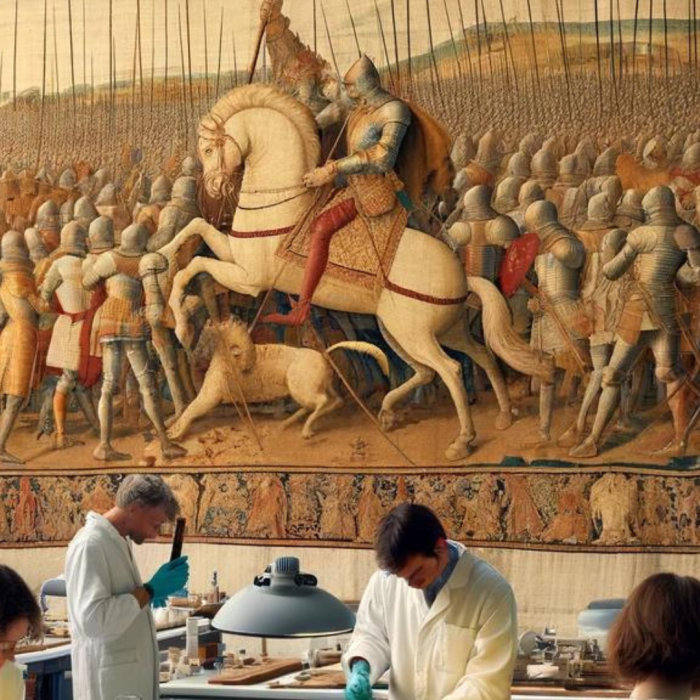The significance of Tapestries in Royal Households
Tapestries, as a form of textile art, have been pivotal in the tapestry of human history, transcending mere decorative items to become storytellers, status symbols, and records of historical events. Their origins trace back to ancient civilizations, where they adorned the walls of temples, palaces, and the homes of the elite, serving not only as art but also as practical insulation. The skill and time required to create these intricate pieces made them luxury items, showcasing the wealth and cultural sophistication of their owners. Over the centuries, tapestries have been used to depict mythological tales, religious stories, battles, and the grandeur of courtly life, becoming an integral part of cultural heritage and artistic expression across the world.
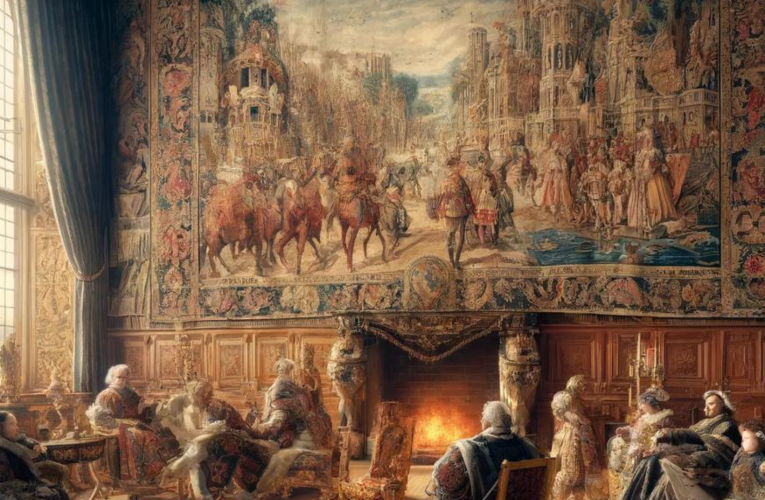
Tapestries in Royal Households: A Cross-Cultural Perspective
In royal households, tapestries were more than just wall decorations; they were symbols of power, prestige, and propaganda. Across different cultures and periods, they played a multifaceted role:
European Royalty
In medieval and Renaissance Europe, tapestries were the epitome of artistry and wealth. They depicted scenes from the Bible, mythology, or the valor of kings, often used to educate, impress, and entertain guests in the grand halls of castles and palaces. The famous Bayeux Tapestry, for instance, provides a narrative of the Norman conquest of England, serving both as a historical document and a monumental work of art.
Islamic Dynasties
In the Islamic world, although the depiction of human and animal figures was often avoided for religious reasons, tapestries still found a place in royal courts as luxurious textiles. Rich fabrics like silk and brocade, often interwoven with gold and silver threads, served similar purposes of showcasing wealth and status.
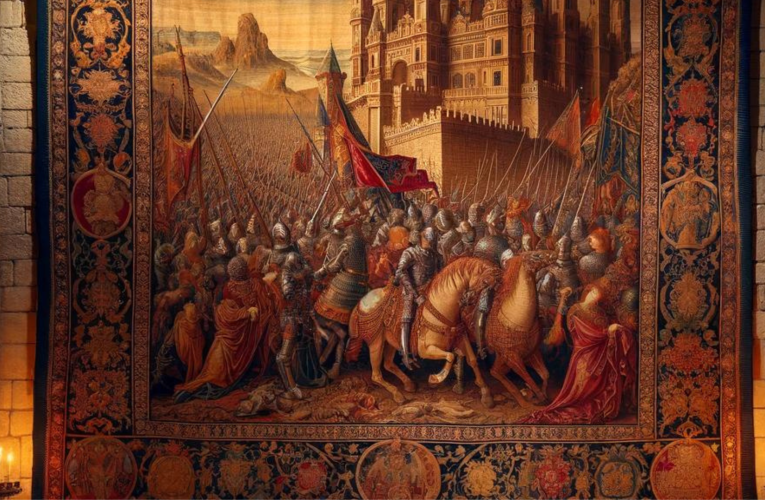
Asian Empires
In China and Japan, tapestries and embroidered textiles held significant importance in royal courts. The Chinese kesi, or silk tapestries, were renowned for their intricacy and elegance, depicting landscapes, floral motifs, and dragon symbolism that conveyed messages of power and prosperity. In Japan, tapestries were used in imperial and noble households to symbolize status and were integral to tea ceremony aesthetics and other cultural rituals.
Tapestries across these cultures and periods were not just decorative items but also tools of diplomacy and cultural exchange. They were often given as prestigious gifts, used to strengthen alliances, or as spoils of war, thereby spreading artistic techniques and styles across continents. Their use in royal households highlights a common thread in human civilization: the desire to surround oneself with beauty that tells a story, commemorates an event, or symbolizes power and authority.
Historical Context and Evolution
Origins of Tapestry Art in Ancient Civilizations
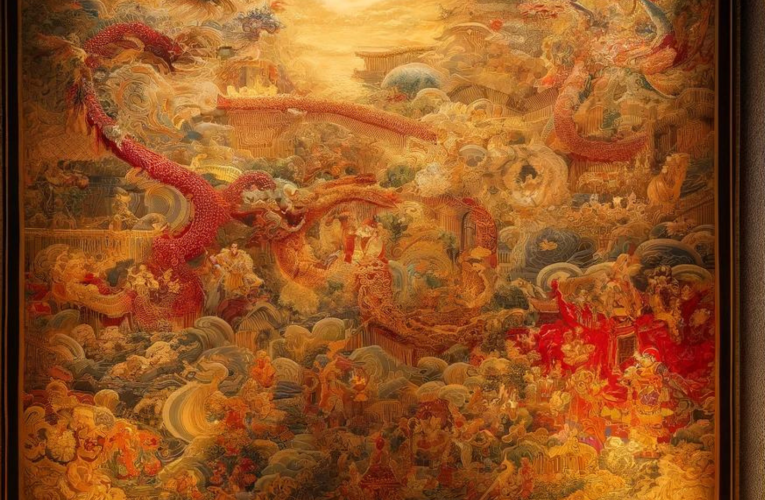
Tapestry art has roots tracing back to ancient civilizations across the globe, from the ancient Egyptians, who used linen to create woven artifacts, to the Incas of South America, known for their intricately woven textiles. Initially, tapestries served practical purposes such as clothing and wall coverings, offering insulation and privacy within dwellings. Over time, these woven artworks began to feature decorative elements, evolving into a form of storytelling and expression. This shift marked the beginning of tapestry art as we understand it today, blending utility with aesthetic appeal.
Evolution from Practical Items to Symbols of Wealth and Power
During the Middle Ages and the Renaissance in Europe, tapestries underwent a significant transformation. They evolved from mere practical items into luxurious symbols of wealth, status, and power. Royal households and the nobility commissioned elaborate tapestries adorned with intricate designs, heraldic symbols, and historical or mythological scenes. These artworks not only beautified and warmed the stark stone interiors of castles and churches but also served as portable symbols of prestige, often given as prestigious gifts or used to display the power and cultural sophistication of their owners during travels or at diplomatic events.
Overview of Techniques and Materials Used Over Time
The techniques and materials used in tapestry-making have evolved considerably over the centuries. Early tapestries were primarily made of wool, providing warmth and durability. As the art form developed, silk, gold, and silver threads were introduced, adding luster and depth to the designs. The weaving techniques also became more sophisticated, allowing for greater detail and a richer palette of colors. By the Renaissance, tapestry workshops in places like Flanders (modern-day Belgium and northern France) were renowned for their skillful artisans and high-quality productions, employing techniques that allowed for intricate shading and perspective, previously unachievable in this medium.
Symbolic Significance
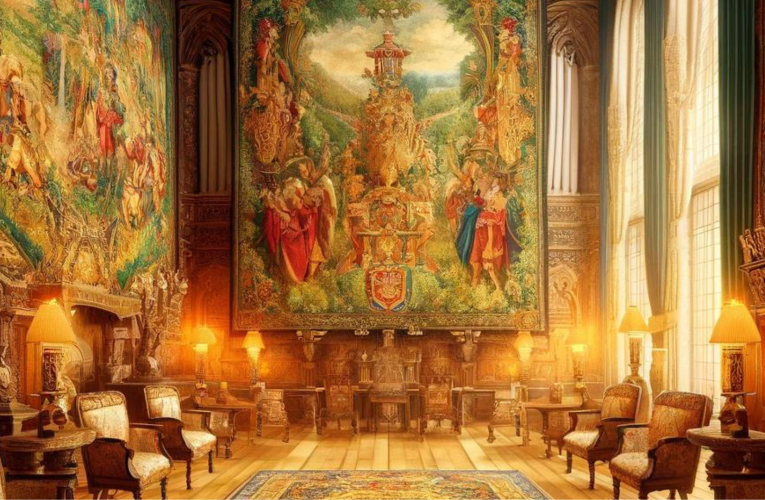
Symbolism in Designs
Tapestries in royal households were not just decorative items; they were rich in symbolism, incorporating elements from religion, mythology, and politics. These intricate designs often depicted biblical stories, mythological epics, and significant historical events. The choice of these themes was deliberate, intended to communicate specific messages or values. For instance, religious motifs could reflect the piety of the household, or mythological themes might symbolize virtues such as bravery or wisdom. Political themes, on the other hand, could serve as a display of allegiance or power, showcasing the royal household’s connections and influence.
Reflection of Ruling Class Values
The tapestries adorning the walls of royal residences were a reflection of the values, beliefs, and aspirations of the ruling class. Through these magnificent works of art, monarchs and nobility could project their desired image both to their contemporaries and to posterity. The content of the tapestries often highlighted the virtues and accomplishments of the rulers, portraying them as wise, just, and divinely sanctioned leaders. By embedding these ideals into everyday surroundings, the ruling class reinforced their authority and legitimacy, and shaped the cultural and moral landscape of their time. These artworks served as a constant reminder of the social hierarchy, with the ruling class at the pinnacle, embodying the highest ideals and virtues of the society they governed.
Tapestries in Royal Households
The Significance of Tapestries in Royal Households
Tapestries, intricate and vast woven artworks, have adorned the walls of royal residences for centuries, serving multiple practical and aesthetic purposes. Their presence in castles and palaces goes beyond mere decoration, encompassing insulation, a display of wealth, storytelling, and historical documentation.
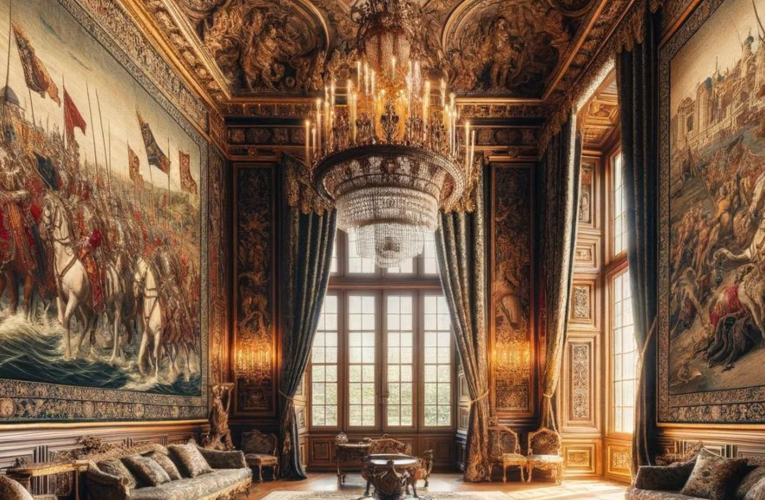
Insulation and Warmth
One of the primary reasons tapestries were favored in royal settings was for their ability to provide insulation within the large, often cold stone walls of castles and palaces. Their thick, woven fabric helped to keep rooms warmer in the winter months, making them essential for comfort and survival in the harsh climates of medieval and early modern Europe.
Display of Wealth and Artistry
Tapestries were not just practical; they were a significant display of wealth and power. The complexity and time it took to create these pieces made them incredibly valuable. They showcased the finest craftsmanship and artistic talent of the time, often depicting intricate designs, landscapes, and heraldic symbols. Possessing elaborate tapestries signified royal prestige and affluence.
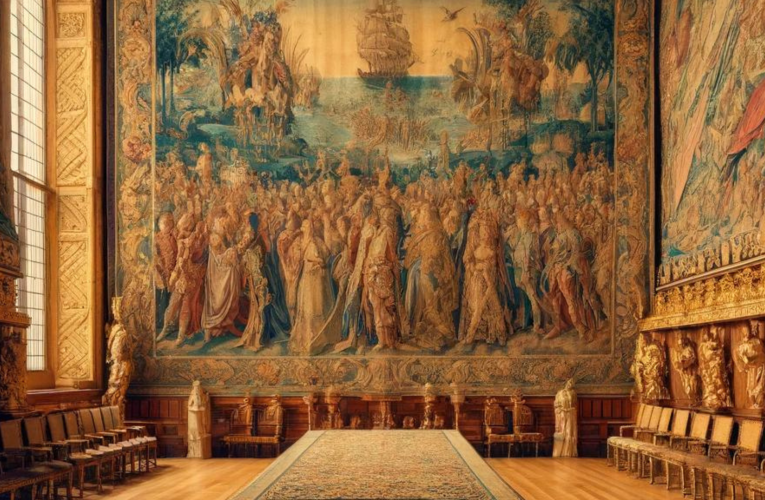
Storytelling and Recording Historical Events
Beyond their beauty and utility, tapestries served as storytelling mediums. They depicted legends, biblical tales, historical events, and achievements of the royalty, acting as visual narratives that educated and entertained. This aspect made tapestries important tools for recording and propagating the history and values of a dynasty.
Notable Examples
Many famous castles and palaces around the world house historic tapestries. The Apocalypse Tapestry in Château d’Angers, France, and the Unicorn Tapestries at The Cloisters in New York City are prime examples. These pieces are not only cherished for their artistic and historical value but also for their ability to transport us back in time, offering a glimpse into the lives and stories of the past.
In sum, tapestries in royal households were multifaceted objects of art and utility. They warmed and adorned vast halls, proclaimed wealth and taste, illustrated stories and history, and continue to fascinate with their complexity and beauty.
The Role of Tapestries in Diplomacy and International Relations
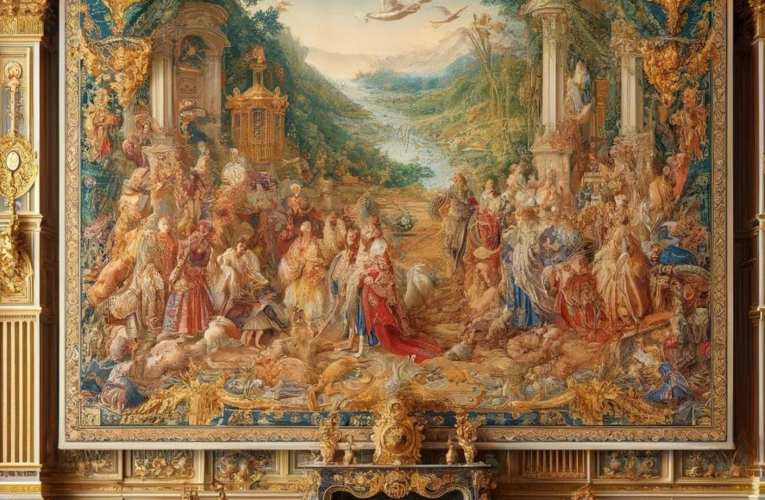
Tapestries as Gifts Among Royalty and Nobility
Tapestries were highly prized assets among royalty and nobility, serving not just as luxurious decorations but as symbols of wealth, power, and cultural sophistication. When presented as gifts, they were potent tools of diplomacy, used to strengthen familial ties between royal houses, seal marriages, and commemorate alliances. These elaborate artworks often depicted scenes of historical, mythological, or allegorical significance, tailored to convey respect and admiration towards the recipient and forge closer ties between elite families.
The Use of Tapestries in Diplomatic Settings to Convey Messages and Forge Alliances
In diplomatic contexts, tapestries were employed as strategic backdrops during significant negotiations and meetings. Their imagery was carefully chosen to project political messages, values, and the status of the host, serving as a non-verbal medium of communication that could reinforce a ruler’s authority, achievements, or divine right to rule. The selection and placement of tapestries in such settings were deliberate, aimed at influencing discussions, demonstrating cultural prowess, and facilitating the formation of alliances. By surrounding visiting dignitaries with symbols of wealth and power, hosts could subtly sway diplomatic outcomes in their favor.
In essence, tapestries in royal households were much more than mere decorative items; they were integral to the fabric of early modern diplomacy, serving as both gifts and symbols with the power to communicate political messages and bind kingdoms together.
Conservation, Restoration, and Public Display
Tapestry conservation presents a unique set of challenges, integral to preserving the cultural and historical significance of these artworks, especially when they grace royal households. The primary difficulty lies in the tapestries’ size and the delicacy of their fibers, which over time may become frail and susceptible to damage. Environmental factors such as light, humidity, and pollution can accelerate their deterioration. Furthermore, tapestries often require specialized cleaning techniques to remove centuries of accumulated dust and grime without harming the fabric. The restoration process demands a meticulous blend of art and science, where conservators must match ancient dyes and weaving techniques to repair damages seamlessly. Once preserved, the public display of tapestries necessitates careful planning to balance accessibility with conservation, ensuring these historical artifacts can be appreciated by future generations without compromising their integrity. The challenges of tapestry conservation underscore the importance of these artifacts as carriers of history and culture in royal households, bridging past and present through their intricate beauty and storytelling.

